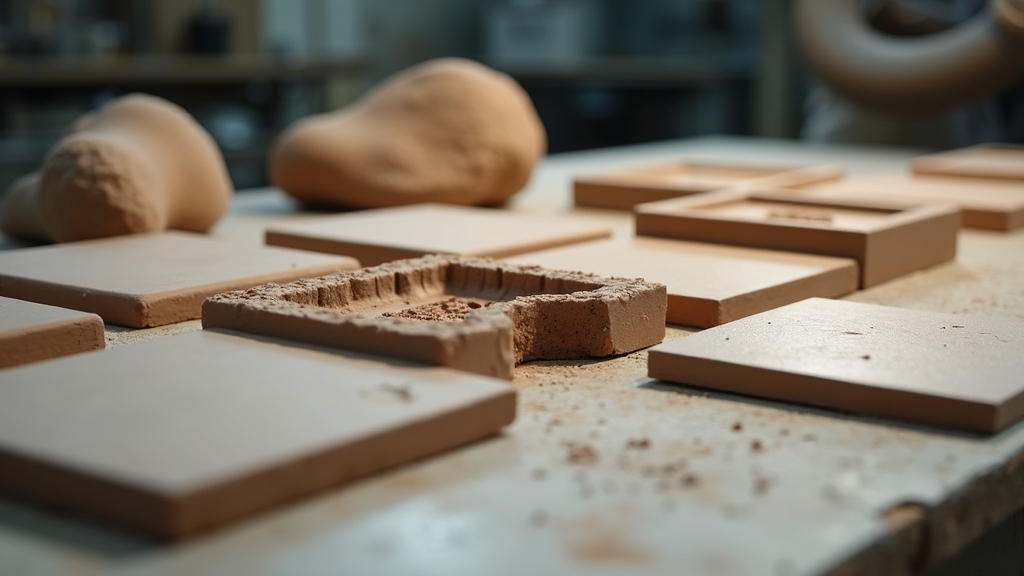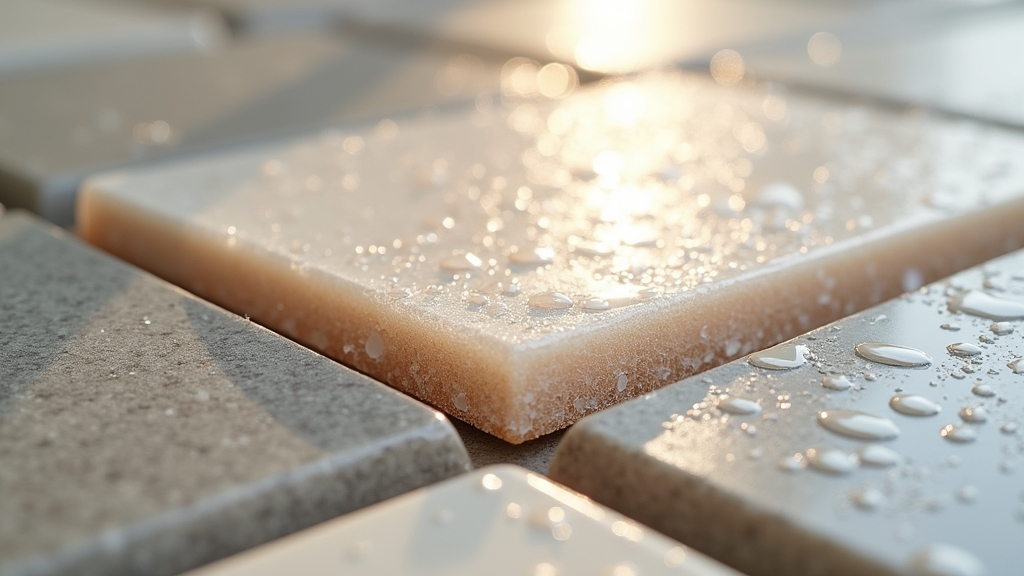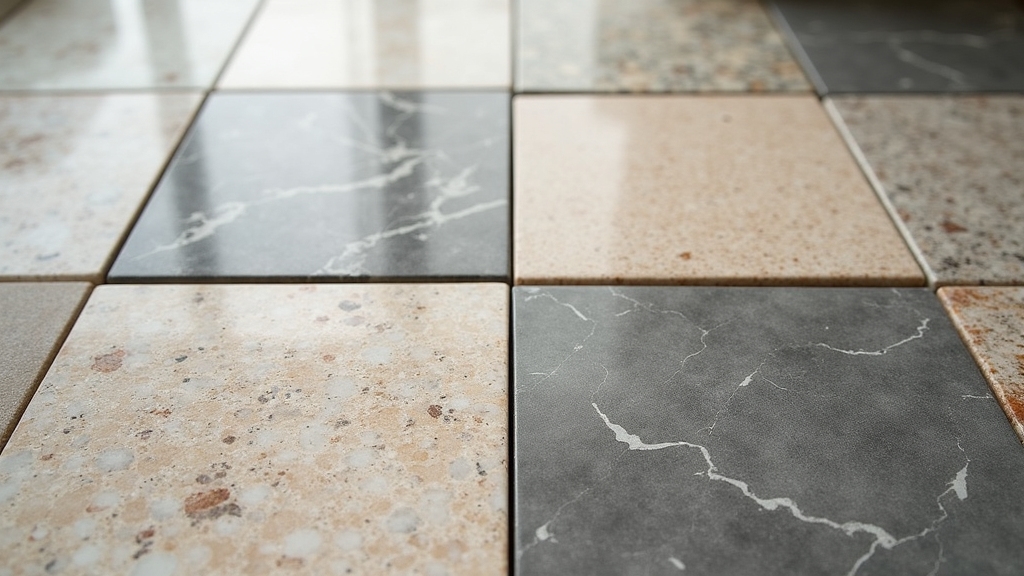You’ll find three distinct tile categories based on composition and manufacturing: ceramic tiles fired at 1,000-1,200°F with 3-7% water absorption, porcelain tiles vitrified at 2,200-2,500°F with under 0.5% absorption, and natural stone varieties requiring specialized installation protocols. Ceramic suits residential applications at $2-$15/sq ft, while porcelain’s Mohs hardness of 7-8 handles commercial traffic. Natural stone demands penetrating sealers and modified thinset mortars. Your substrate preparation, moisture conditions, and traffic patterns will determine which material specification meets your performance requirements and budget parameters.
Key Takeaways
- Ceramic tiles are fired at lower temperatures (1,000-1,200°F) with 3-7% water absorption, suitable for light residential use and interior walls.
- Porcelain tiles are vitrified at 2,200-2,500°F with under 0.5% water absorption, offering superior durability for high-traffic commercial and exterior applications.
- Natural stone varieties like marble, granite, and travertine require specific sealers, with reapplication intervals ranging from 6 months to 2 years.
- Material costs vary significantly: ceramic ($2-$15/sq ft), porcelain ($3-$25/sq ft), and natural stone ($5-$50/sq ft), plus increased installation labor.
- Maintenance requirements differ by tile type: ceramic needs pH-neutral cleaners, porcelain requires non-abrasive solutions, and stone demands acid-free formulations.
What Makes Ceramic Tile Different: Composition and Manufacturing

Because ceramic tile derives its fundamental properties from clay-based materials, understanding its composition directly impacts your installation approach and long-term performance expectations.
Ceramic tile’s clay-based composition determines critical installation requirements and dictates realistic performance expectations for your specific application.
The manufacturing process begins with refined natural clay mixed with minerals and water, then shaped through extrusion or pressing. Firing temperatures reach 1,000-1,200°F, creating a porous bisque body with water absorption rates between 3-7%. This porosity distinguishes ceramic tile from denser alternatives and necessitates specific substrate preparation and adhesive selection.
The glazing application—either single or double-fired—determines surface hardness, stain resistance, and coefficient of friction.
You’ll find ceramic tile exhibits lower breaking strength compared to vitrified products, requiring proper deflection management in your substrate assembly. Its composition makes it suitable for wall applications and light-to-moderate floor traffic where budget constraints exist.
The Unique Properties of Porcelain Tile

Vitrification—the process of transforming clay into a glass-like material—sets porcelain tile apart from standard ceramic through extreme firing temperatures of 2,200-2,500°F and specialized feldspar-rich compositions. This creates a water absorption rate below 0.5%, making it impervious and suitable for freeze-thaw environments where moisture infiltration compromises lesser materials.
You’ll find porcelain’s through-body construction eliminates concerns about chipping visibility, as color variations extend throughout the tile’s depth rather than residing in surface glazing alone.
The dense matrix yields a Mohs hardness rating of 7-8, resisting scratches from foot traffic and abrasive particles. When specifying porcelain with a glossy finish, you’re selecting enhanced stain resistance but reduced slip resistance—critical considerations for wet installations.
Installation requires modified thin-set mortars and diamond-blade cutting tools due to porcelain’s exceptional density.
Natural Stone Tile Varieties: Marble, Granite, Travertine, and Slate

Unlike manufactured tiles that achieve consistency through controlled production, natural stone varieties introduce geological variables that demand adaptive installation strategies and material-specific treatments.
Natural stone’s inherent geological complexity requires installers to abandon standardized approaches in favor of material-responsive techniques and adaptive methodologies.
Critical Stone Selection Factors:
- Marble varieties range from Carrara’s veined elegance to Calacatta’s bold patterning, each requiring specific sealers and mortar chemistry to prevent etching and staining.
- Granite textures span polished, honed, and flamed finishes—demanding diamond blade cutting and epoxy-modified thinset for secure bonding.
- Travertine finishes present filled or unfilled options, with unfilled surfaces requiring grouting techniques that address inherent voids without surface contamination.
- Slate colors vary from gray to multicolor blends, with cleft surfaces necessitating back-buttering applications and lippage management systems.
You’ll need substrate preparation protocols that accommodate natural thickness variations and absorption rate differentials across stone types.
Comparing Durability and Longevity Across Tile Types
When specifying tile for your installation, you’ll need to evaluate each material’s performance characteristics against your project’s traffic demands and environmental conditions.
Ceramic tile offers adequate wear resistance for residential applications, while porcelain‘s dense vitrified body delivers superior compressive strength and moisture impermeability for high-traffic commercial settings.
Natural stone requires scheduled sealing and pH-neutral maintenance protocols to preserve its structural integrity and prevent surface degradation over its service life.
Ceramic Tile Wear Resistance
The Porcelain Enamel Institute (PEI) rating system quantifies ceramic tile’s resistance to surface wear through standardized abrasion testing, ranging from PEI Class 0 (no foot traffic) to PEI Class 5 (heavy commercial traffic).
You’ll need to match your ceramic tile specification to actual traffic conditions for ideal performance.
Critical PEI Classifications for Installation Planning:
- PEI Class 1-2: Wall applications and residential bathrooms where minimal abrasion occurs
- PEI Class 3: Standard residential floors including kitchens, entries, and countertops with moderate traffic
- PEI Class 4: Medium commercial installations such as restaurant dining areas and office lobbies
- PEI Class 5: Heavy-duty commercial environments including retail corridors and institutional facilities
Your wear resistance selection directly impacts long-term maintenance costs and replacement frequency.
Verify manufacturer testing documentation before specifying.
Porcelain’s Superior Strength
Porcelain tile achieves its exceptional strength through a manufacturing process that subjects refined clay to temperatures exceeding 2,200°F—approximately 400°F higher than standard ceramic production.
This vitrification process yields a water absorption rate below 0.5%, resulting in a density that translates directly to field performance.
When you’re conducting a strength comparison between porcelain tiles and ceramic alternatives, you’ll find porcelain’s breaking strength typically exceeds 250 pounds per square inch—nearly double that of standard ceramic.
This structural integrity makes porcelain tiles essential for high-traffic commercial installations and exterior applications where freeze-thaw cycles demand superior durability.
You’ll also note their Class 5 PEI rating, indicating maximum abrasion resistance.
For projects requiring longevity without compromising load-bearing capacity, porcelain’s molecular structure provides unmatched performance metrics.
Natural Stone Maintenance Needs
While porcelain’s engineered composition minimizes maintenance demands, natural stone tiles require fundamentally different care protocols due to their geological origins and porous microstructures.
You’ll need to implement rigorous surface sealing regimens to prevent moisture infiltration and staining.
Consider these critical maintenance requirements:
- Initial Sealing Protocol: Apply penetrating sealers within 48 hours post-installation, ensuring complete absorption into the stone’s capillary structure.
- Resealing Schedule: Execute reapplication every 6-18 months depending on stone density and traffic patterns.
- pH-Neutral Cleaning Products: Use only pH-balanced formulations; acidic or alkaline cleaners irreversibly etch calcite-based stones like marble and travertine.
- Immediate Spill Response: Remove acidic substances within minutes to prevent chemical etching and permanent discoloration.
Stone’s inherent porosity demands proactive maintenance rather than reactive cleaning approaches.
Water Resistance and Moisture Performance
When selecting tile for moisture-prone installations, you’ll need to evaluate each material’s water absorption rate and dimensional stability under wet conditions.
Porcelain tile excels with absorption rates below 0.5%, making it ideal for wet zones and freeze-thaw environments.
Ceramic tile ranges from 3-7% absorption, requiring proper waterproofing membranes in shower and steam applications.
Natural stone varies considerably—dense granite exhibits excellent moisture resistance at 0.4% absorption, while travertine’s 2-5% porosity demands sealing protocols.
You’ll find that water absorption directly impacts efflorescence potential, freeze damage susceptibility, and substrate bond integrity.
For commercial installations exceeding 50% relative humidity, specify porcelain or sealed natural stone.
Test dimensional stability by monitoring coefficient of thermal expansion under saturated conditions, particularly for large-format installations where movement joints become critical.
Cost Considerations: Initial Investment and Long-Term Value
Beyond moisture performance specifications, your tile selection directly impacts project economics through material costs, installation labor rates, and lifecycle maintenance requirements.
Understanding the total cost of ownership enables informed material specification decisions.
Cost Analysis Framework:
- Material Acquisition – Ceramic tiles range $2-$15/sq ft, porcelain $3-$25/sq ft, while natural stone commands $5-$50/sq ft depending on rarity and processing requirements.
- Installation Labor – Natural stone demands specialized cutting tools and skilled craftsmen, increasing labor costs 40-60% over ceramic installations.
- Substrate Preparation – Heavier materials require reinforced underlayment systems, adding $3-$8/sq ft to project budgets.
- Maintenance Economics – While initial costs favor ceramic, porcelain’s superior durability and stone’s refinishing capability often deliver better long term investment returns through extended replacement cycles.
Maintenance Requirements for Each Tile Category
Proper tile maintenance directly impacts material longevity and performance characteristics across all categories.
You’ll need to establish daily cleaning protocols specific to each tile type’s porosity rating and surface finish, whether you’re working with glazed ceramic, natural stone, or porcelain installations.
Sealing schedules vary considerably—dense porcelain may require minimal treatment while porous travertine demands regular penetrating sealer application to prevent moisture infiltration and staining.
Daily Cleaning Best Practices
Each tile category demands specific cleaning protocols that directly impact long-term performance and aesthetic retention. Your daily cleaning regimen must align with substrate-specific properties to prevent degradation and maintain surface integrity.
Essential Tile Care Protocols:
- Ceramic tiles require pH-neutral cleaners applied with microfiber applicators to preserve glaze integrity and prevent chemical etching.
- Porcelain installations demand non-abrasive solutions that won’t compromise the through-body composition or textured surface treatments.
- Natural stone substrates need stone-specific formulations excluding acids or alkalines that penetrate porous matrices and cause discoloration.
- Grout lines across all categories necessitate targeted cleaning with soft-bristle brushes to remove debris without compromising joint stability.
You’ll maximize tile longevity by implementing substrate-appropriate daily cleaning techniques rather than universal maintenance approaches that risk material-specific damage.
Sealing and Long-Term Care
While daily cleaning maintains surface cleanliness, strategic sealing protocols determine whether your tile installation withstands decades of service or requires premature replacement.
Natural stone demands immediate penetrating sealer application post-installation, with reapplication intervals varying by stone porosity—marble every 6-12 months, granite annually, slate every 1-2 years.
You’ll need to verify water-beading performance to confirm adequate protection.
Unglazed porcelain benefits from optional sealing in high-traffic commercial applications, though glazed porcelain requires no sealing whatsoever.
Ceramic tile’s glazed surface eliminates sealing requirements entirely.
Long term maintenance extends beyond surface treatments—grout joints require dedicated sealing every 1-2 years using epoxy-based or penetrating sealers.
Professional resealing services guarantee proper sealing methods when DIY applications prove insufficient for demanding environments.
Best Applications: Where Each Tile Type Excels
When selecting tile for a specific installation, understanding substrate conditions, moisture exposure, and traffic patterns determines which material will deliver ideal performance.
Best Tile Applications by Material Type:
- Ceramic Tile – Interior walls, backsplashes, and light-traffic residential floors where design aesthetics prioritize color variation and budget constraints exist.
- Porcelain Tile – High-traffic commercial spaces, exterior installations, and wet environments requiring superior water resistance and dimensional stability.
- Natural Stone – Feature walls, luxury residential applications, and horizontal surfaces where unique veining and patina development enhance design intent.
- Glazed vs. Unglazed – Glazed surfaces for walls and decorative tile applications; unglazed porcelain for slip-resistant flooring and freeze-thaw exposure.
Material selection directly impacts installation methodology, substrate preparation requirements, and long-term maintenance protocols.
Match tile composition to environmental demands for best performance outcomes.
Making Your Final Selection: Key Factors to Consider
Before committing to a tile selection, you’ll need to evaluate six critical decision factors that influence both installation success and lifecycle performance.
First, assess substrate conditions and loading requirements—structural capacity dictates material weight limitations.
Second, analyze environmental exposure: freeze-thaw cycles, chemical contact, and moisture levels determine durability thresholds.
Third, calculate coefficient of friction (COF) values for slip resistance compliance.
Fourth, establish maintenance protocols matching your operational capacity—sealing frequency and cleaning intensity vary considerably.
Fifth, verify installation method compatibility with substrate type and tile format.
Sixth, balance style preferences and aesthetic considerations against performance specifications—visual appeal shouldn’t compromise functional requirements.
These factors interact systematically; overlooking one compromises the entire installation’s integrity and longevity.
Frequently Asked Questions
Can I Install Tile Flooring Myself or Should I Hire a Professional?
You can attempt DIY installation if you’ve mastered substrate preparation, layout geometry, and thinset application techniques. However, professional considerations include lippage prevention, waterproofing membrane integration, and complex pattern execution—factors that’ll determine your project’s long-term performance and aesthetic success.
How Long Does Tile Installation Typically Take for an Average-Sized Room?
For an average-sized room, you’ll need 2-3 days for complete tile installation. Your installation timeline depends on room size, substrate prep, mortar curing time, and grouting. Professional installers can expedite the process considerably.
What Type of Grout Works Best With Each Tile Material?
You’ll need to match grout types to tile compatibility: use unsanded grout for narrow joints in polished natural stone, sanded grout for ceramic and porcelain with wider spacing, and epoxy grout for maximum stain resistance across all materials.
Are There Eco-Friendly or Sustainable Tile Options Available?
You’ll find eco-friendly tiles manufactured from recycled materials like reclaimed glass, post-consumer ceramics, and repurposed stone aggregate. Verify sustainable sourcing certifications before installation, ensuring proper thinset compatibility with recycled content tiles for ideal adhesion and longevity.
Can Radiant Floor Heating Be Installed Under All Tile Types?
You’ll find radiant heating compatibility across ceramic, porcelain, and natural stone tiles when you follow proper tile installation methods. You must guarantee adequate thermal conductivity, use modified thinset, and maintain manufacturer-specified substrate temperatures for best performance.
Final Thoughts
Selecting the right tile goes far beyond aesthetics — it’s a strategic decision that directly impacts your space’s longevity, safety, and overall value. By understanding the differences between ceramic, porcelain, and natural stone, you can confidently align each material’s properties with your specific environment, substrate conditions, and design vision.
Ceramic remains ideal for cost-effective residential projects and decorative applications, while porcelain delivers the strength, water resistance, and durability demanded by high-traffic and outdoor areas. For a timeless, luxurious finish, natural stone offers unmatched beauty — but also requires specialized sealing, installation, and care to preserve its natural integrity.
If you’re looking to ensure your tile installation exceeds industry standards, partner with the professionals at Atlanta Tile Installer. Our team specializes in bathroom tile installation, kitchen tile design, flooring installation, and even intricate custom tile designs that bring both function and artistry to your home.
Serving homeowners across Atlanta, Lawrenceville, Johns Creek, and Sandy Springs — we’re dedicated to helping you choose the perfect materials and achieve a flawless installation built to last.
Ready to elevate your space with expert tile craftsmanship?
Contact Atlanta Tile Installer today for a free consultation and discover why homeowners across Georgia trust our team for precision, quality, and exceptional results.

